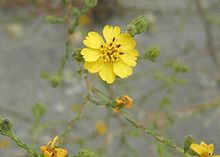Deinandra conjugens
| Deinandra conjugens | |
|---|---|

| |
| Scientific classification | |
| Kingdom: | Plantae |
| Clade: | Tracheophytes |
| Clade: | Angiosperms |
| Clade: | Eudicots |
| Clade: | Asterids |
| Order: | Asterales |
| Family: | Asteraceae |
| Genus: | Deinandra |
| Species: | D. conjugens
|
| Binomial name | |
| Deinandra conjugens | |
| Synonyms[2] | |
|
Hemizonia conjugens D.D.Keck | |
Deinandra conjugens (
Deinandra conjugens is threatened by habitat destruction and degradation.[4] It was federally listed as a threatened species in 1998.[1]
Description
Deinandra conjugens is an annual herb growing up to about 0.5 metres (1.6 ft) in height with a solid, bristly, gland-dotted stem. The lower leaves are hairy and lobed or toothed, and measure up to about 4.5 centimeters long.[5]
The
The fruit is an
Distribution
Deinandra conjugens grows in clay soils in several types of habitat, including grassland and maritime and inland coastal sage scrub.[4] It tolerates some disturbance in its habitat, and low levels of grazing and road maintenance activities such as mowing are probably beneficial.[4][1]
Most of the known occurrences of Deinandra conjugens are in
Conservation
The region in which the plant lives is heavily impacted by development and other processes and exists now in a fragmented state. 70% of the plant's habitat within its range has been destroyed. Much of the territory previously threatened by development has been conserved within a number of nature reserves. Many are protected under a San Diego county ordinance. The San Diego National Wildlife Refuge created the Otay Tarplant Preserve, and Caltrans reserved a section of land for the plant near a busy highway.[4] While many California populations are now protected, there are still many that are in danger of destruction. The status and distribution of this plant within Mexico are unknown.[4]
Besides outright habitat destruction, the plant is affected by several processes of habitat degradation.
References
- ^ a b c d Deinandra conjugens. The Nature Conservancy.
- ^ The Plant List, Deinandra conjugens (D.D.Keck) B.G.Baldwin
- ^ Calflora taxon report, University of California, Deinandra conjugens (Keck) B.G. Baldwin, Otay tarplant
- ^ a b c d e f g h USFWS. Deinandra conjugens Five-year Review. June 2009.
- ^ a b c Deinandra conjugens. Flora of North America.
- ^ Hemizonia conjugens. Jepson Manual.
- ^ a b c Deinandra conjugens (Otay Tarplant). City of San Diego Rare Plant Monitoring Report, 2005.
External links
 Media related to Deinandra conjugens at Wikimedia Commons
Media related to Deinandra conjugens at Wikimedia Commons- Jepson eFlora (TJM2) treatment of Deinandra conjugens
- Jepson Manual (TJM93), archived: Hemizonia conjugens
- United States Department of Agriculture Plants Profile - Deinandra conjugens (Otay tarweed)
- Deinandra conjugens — Calphotos Photos Gallery, University of California

